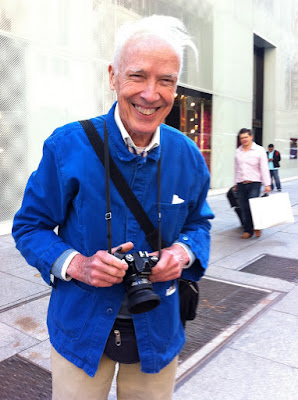 |
| Photo courtesy of Lenzartis |
One of my heroes passed
last week. Bill Cunningham first drew my
attention when I saw a documentary about him.
He was a tiny wisp of a man, always with a blue smock jacket, his
bicycle, and his camera as he raced through the streets of midtown Manhattan
photographing street fashions for his weekly spread in The New York Times. At
night, he hovered and flitted through the summer garden parties of the rich and
famous to document the gatherings in a second collection prominent in the paper’s
Sunday Style section. At 87, he seemed
indestructible, that he would go on for ages and ages even though he appeared
delicate and child-like. No one does the
kind of work Bill did. He was an artist
living an ascetic life. His photography
was everything to him. I admired his
singular focus, his obsession with his art.
Like most true artists, he would continue even if no one paid him. In fact, there were times in his career when
he tore up his paychecks. He wanted to
be unbiased in his approach to fashion and culture. To accept payment meant that he was beholden
to someone, and that was not acceptable to the way Bill worked. He eventually took the job at the Times for
the health insurance. The paper and its
editors let Bill do what he did best, working with film long after most professional
photographers had switched to digital.
He eventually did make the change but on his own terms, continuing his painstaking
process of editing hundreds of photographs down to the select few that appeared
in the paper each week.
Of course, when I
first saw the documentary, I started carrying a camera everywhere with me, but
I quickly realized there was only one Bill Cunningham, and although I loved his
pure artistry and focus, I did not have the eye, the quick shutter reflex, the
diligence. I am more suited to word
pictures. Besides, Los Angeles and its
attention-seeking whores are far less photogenic and fashionable than their
counterparts in New York. And as the
band Missing Persons told us all those years ago, nobody walks in L.A. Bill Cunningham photographed a city, an
attitude, an aesthetic unique to a time and place; it cannot be duplicated.
It is admirable and
necessary what Bill did for forty years, traveling through the streets and
lives of New Yorkers with a camera, documenting the color and beauty of fashion
on the avenue. He caught it all: “fanny packs…Birkin bags…gingham shirts…florescent
biker shorts,” according to his obituary in the paper for which he worked. He was an artist, social scientist, an
anthropologist. In the documentary, we
see his stuffed file cabinets in his monk-like cell above Carnegie Hall where
he slept on a tiny cot and shared a communal bathroom with other
residents. He delights in his simple
breakfast at the Stage Star Deli on West 55th Street: a sausage, egg
and cheese breakfast sandwich and a cup of coffee for three bucks. “Money is the cheapest thing,” he said when
asked why he ripped up some of his paychecks.
“Liberty and freedom is the most expensive.”
He literally amassed
thousands of images in his archive.
Hopefully, some museum will snap up that archive, organize it, and open
it for scholars and the general public.
These words from his obituary come closest to an artist’s credo: “When I’m photographing, I look for the
personal style with which something is worn—sometimes even how an umbrella is
carried or how a coat is held closed. At
parties, it’s important to be almost invisible, to catch people when they’re
oblivious to the camera—to get the intensity of their speech, the gestures of
their hands. I’m interested in capturing
a moment with animation and spirit.”
I would like to think
his spirit is still on the streets of Manhattan, capturing the beauty of
another day in a springtime that will last an eternity. Godspeed, Bill.
To hear more about
what it was like to work with Bill Cunningham on a daily basis, read this essay
from his assistant.